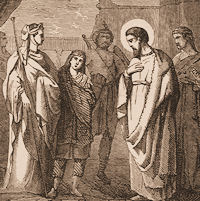Ordinary Time: January 25th
Feast of the Conversion of St. Paul, Apostle
Other Commemorations: St. Evaristus, Pope and Martyr (RM)
» Enjoy our Liturgical Seasons series of e-books!
The Feast of the Conversion of St. Paul celebrates St. Paul turning away from persecution of Christians to promoting Christianity. St. Paul, named Saul at his circumcision, a Jew of the tribe of Benjamin, was born at Tarsus, the capital of Cilicia. He was a Roman citizen. He was brought up as a strict Jew, and later became a violent persecutor of the Christians. While on his way to Damascus to make new arrests of Christians, he was suddenly converted by a miraculous apparition of Our Lord. From a fierce persecutor he became the great Apostle of the Gentiles. He made three missionary journeys which brought him to the great centers of Asia Minor and southern Europe, and made many converts. Fourteen of his Epistles are found in the New Testament. He was beheaded in Rome around 66 A.D., and his relics are in the Basilica of St. Paul Outside-the-Walls near the Ostian Way.
Today concludes the Week of Prayer for Christian Unity, January 18-25. The theme for 2024 is: "You shall love the Lord your God… and your neighbor as yourself." —Luke 10:27
St. Evaristus
The episcopate of Evaristus began in the third year of Emperor Trajan's reign. Sources refer to him as a Greek from Antioch, the son of a Jew named Juda from Bethlehem. The exact length of his reign has been disputed by historians, as have been the authenticity of his letters and decretals; however, early scholars credit Evaristus with dividing Rome into specific parishes and with ordaining fifteen bishops, seven priests, and two deacons. Lack of historical evidence for these acts, though, would make them questionable.
In his first epistle addressed to the bishops of Africa, Evaristus decreed that seven deacons were to monitor a bishop's preaching, to ensure that he did not lapse from the true teachings. Evaristus did not wish to see undue accusations aimed at his bishops, yet reserved solely to the See of Rome the power to terminate any bishop as a result of this indiscretion. His second epistle drew a comparison between the lasting bond of husband and wife and that of a bishop and his diocese. Fragments of certain documents bearing his name have been proved to be forgeries, and therefore the validity of his epistles is doubtful. Evaristus did, however, live long enough to see the beginning of the Antonine dynasty.
According to Church tradition, he died a martyr and was buried near St. Peter on the Vatican Hill, but again, there is no reliable evidence to support this.
—Excerpted from The Popes: A Papal History, J.V. Bartlett
Highlights and Things to Do:
- Read more about St. Evaristus:






